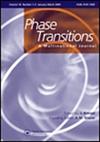一种新型的希夫碱配体功能化硫化锌纳米复合材料用于重金属检测和光催化染料降解
IF 1.4
4区 材料科学
Q3 CRYSTALLOGRAPHY
引用次数: 0
摘要
摘要在此,我们报道了使用基于纳米技术的方法检测和去除/降解金属离子和染料物种。采用无溶剂法制备了席夫碱配体;之后,配体用于在水性介质中官能化硫化锌纳米颗粒(ZnS NP)。Sb–ZnS NPs被证明是一种双探针,即用于检测Pb2+、Hg2+和Fe3+离子,以及作为降解亚甲基蓝(MB)染料的光催化剂。在日光照射下使用Sb–ZnS NP光催化剂的实验显示,MB降解率为96%,比在黑暗中仅降解66%的染料效率更高。此外,染料的降解遵循一阶速率动力学,光照样品的速率常数较高(16.3 × 10−4 min−1)比保持在黑暗中的(6.85 × 10−4 最小−1)。UV–Vis、PL、FT-IR、TEM和粉末XRD分析已被常规用于本研究。本文章由计算机程序翻译,如有差异,请以英文原文为准。
A novel nanocomposite comprising Schiff base ligand functionalized zinc sulphide nanoparticles for heavy metal detection and photocatalytic dye degradation
ABSTRACT Herein, we report the detection and removal/degradation of metal ions and dye species using nanotechnology-based approach. A Schiff base (Sb) ligand has been prepared by a solvent-less method; post which, the ligand is used for functionalizing zinc sulphide nanoparticles (ZnS NPs) in the aqueous medium. The Sb–ZnS NPs proved to be a dual probe, viz., for the detection of Pb2+, Hg2+ and Fe3+ ions, and as a photocatalyst for the degradation of methylene blue (MB) dye. The experiments using the Sb–ZnS NP photocatalyst under daylight illumination revealed higher efficiency with 96% degradation of MB than that in the dark with only 66% degradation of the dye. Further, the degradation of the dye followed first-order rate kinetics with a higher rate constant for light-illuminated sample (16.3 × 10−4 min−1) than the one kept at dark (6.85 × 10−4 min−1). UV–Vis, PL, FT-IR, TEM and powder XRD analyses have been routinely used for the present investigation.
求助全文
通过发布文献求助,成功后即可免费获取论文全文。
去求助
来源期刊

Phase Transitions
物理-晶体学
CiteScore
3.00
自引率
6.20%
发文量
61
审稿时长
1.4 months
期刊介绍:
Phase Transitions is the only journal devoted exclusively to this important subject. It provides a focus for papers on most aspects of phase transitions in condensed matter. Although emphasis is placed primarily on experimental work, theoretical papers are welcome if they have some bearing on experimental results. The areas of interest include:
-structural phase transitions (ferroelectric, ferroelastic, multiferroic, order-disorder, Jahn-Teller, etc.) under a range of external parameters (temperature, pressure, strain, electric/magnetic fields, etc.)
-geophysical phase transitions
-metal-insulator phase transitions
-superconducting and superfluid transitions
-magnetic phase transitions
-critical phenomena and physical properties at phase transitions
-liquid crystals
-technological applications of phase transitions
-quantum phase transitions
Phase Transitions publishes both research papers and invited articles devoted to special topics. Major review papers are particularly welcome. A further emphasis of the journal is the publication of a selected number of small workshops, which are at the forefront of their field.
 求助内容:
求助内容: 应助结果提醒方式:
应助结果提醒方式:


